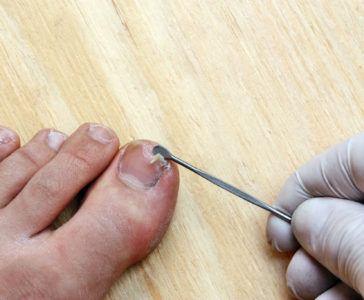 If you’ve suffered trauma to your big toe, there’s a chance that the nail bed might become loose immediately or a ways down the road. Should you help remove the broken toenail, or should you leave it on to help protect against dirt and germs? We explain what you should do if your toenail is falling off in this blog.
If you’ve suffered trauma to your big toe, there’s a chance that the nail bed might become loose immediately or a ways down the road. Should you help remove the broken toenail, or should you leave it on to help protect against dirt and germs? We explain what you should do if your toenail is falling off in this blog.
Toenail Falling Off
How you handle a broken or loose nail depends on the extent of damage. Let’s start with minor or mild tears or cracks and work our way to more extreme trauma. For example, let’s say you stubbed your toe and suffered a cracked nail. If the crack isn’t too deep, start by stopping any bleeding or by soaking your foot in cold water. Once bleeding has stopped, examine the nail and trim back any part that might catch on socks or clothes using a disinfected pair of nail clippers. If the crack is not likely to catch on your clothes, you don’t need to cut it.
If the nail bed is exposed due to damage or cutting back the broken part, apply some anti-bacterial ointment and protect the surface with a bandage until the area has time to harden, which usually takes about a week. Change the bandage daily or if it gets wet. Elevating the toe and taking anti-inflammatory medications can help with swelling, inflammation and pain.
Wear closed toe shoes to keep the toenail protected, unless it is too painful to put into a shoe. Then wear appropriate sandals.
Serious Toenail Damage
If you have severe toenail damage and are uncomfortable caring for the nail yourself, call a doctor or a foot specialist like Dr. Silverman. He can either trim back the nail, or if damage is more severe, he can numb the toe and remove the toenail to help start the healing process. He will remove the damaged nail, disinfect the area and apply a bandage to keep it protected.
In other instances, people will suffer toenail trauma, and while the nail remains fully intact, it will actually be damaged to the point that eventually it will fall off. You’ll notice blood pooling under the nail, but it may not be loose just yet. Don’t pick at the nail, because it’s still offering your nail bed plenty of protection. Keep an eye on it, and odds are it will fall off on its own days or weeks down the road. When this happens, you can either call a specialist or manage it using the above techniques, which includes applying anti-bacterial cream, wrapping it in non-stick bandages, regularly changing your dressing and watching for signs of an infection. Slowly but surely, the nail will grow back on its own.
If, after suffering toenail trauma, pain gets worse or you notice signs of an infection, contact a foot specialist right away. Aside from caring for the nail itself, they can also determine if you’ve suffered more extensive injuries like a toe or joint fracture.
Damaged toenails can often be cared for by the patient so long as pain is mild and they actively clean and care for the toe, but if you need more help or have serious symptoms, contact Dr. Silverman’s office today.